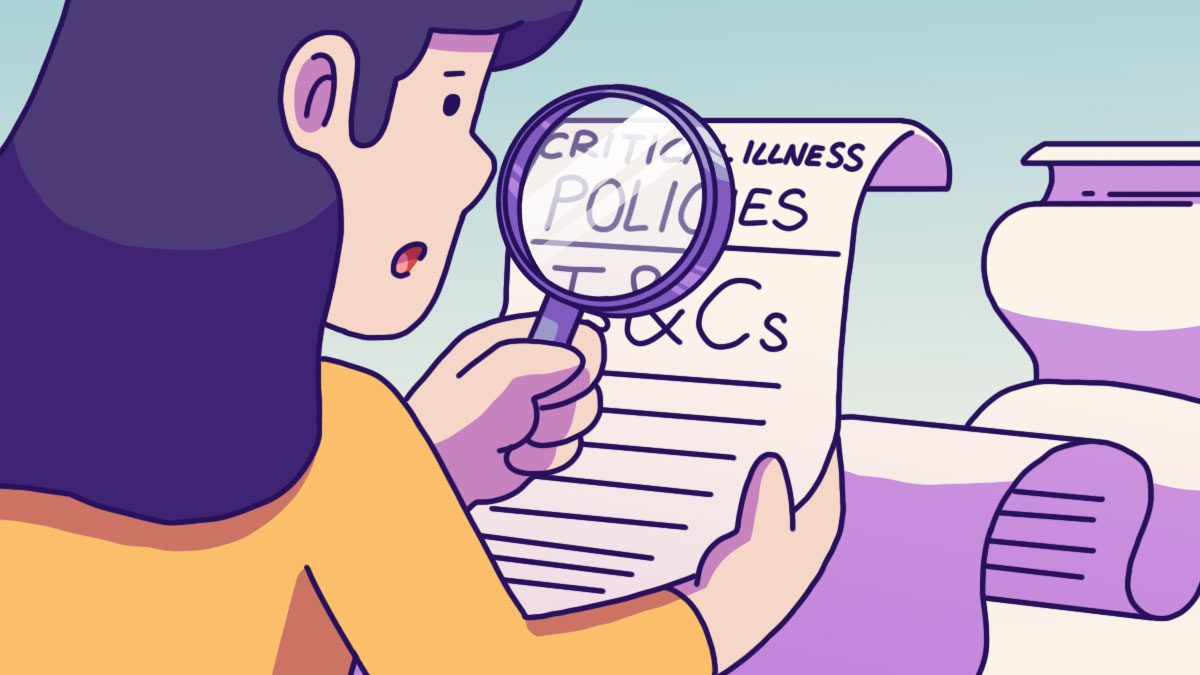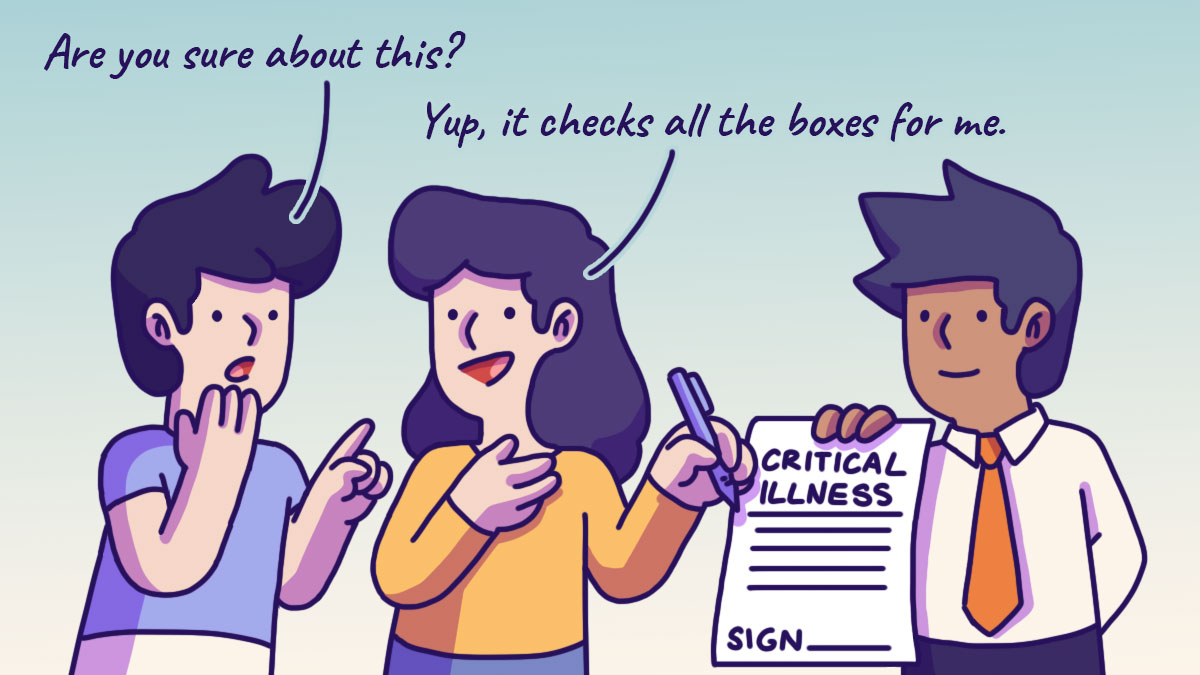Financial Planning | Personal Finance | Article
5 Things to Consider Before You Purchase Any Critical Illness Plan
by The Simple Sum Team | 4 Dec 2023 | 8 mins read

This article is brought to you by FWD Singapore
Nobody likes thinking about the possibility of being diagnosed with a critical illness (CI) like cancer or a stroke.
It is, understandably, a scary thought.
You may think that the odds of you being this “lucky” is low, but according to the Singapore Cancer Registry1, two in five people in Singapore may develop cancer in their lifetime. And if you’re not financially prepared and it happens to you, you’ll have to worry about how you’re going to pay for your medical bills and make ends meet while you’re dealing with a life-threatening illness.
That’s why, at the very least, you should consider getting health insurance that covers your medical bills while you’re seeking treatment. To give you an additional safety net, it’s also prudent to get critical illness coverage as the payout will help you cope with your daily expenses.
Why it’s important to get critical illness protection
Critical Illness (CI) insurance pays you a lump sum if you’re diagnosed with a critical illness or if you’ve undergone a treatment that’s covered by the insurance plan.
Unlike your standard health insurance that only reimburses your medical bills, you can use the payout from your CI plan to cover non-medical costs, which include anything from travel costs to the hospital, and adaptive furniture in your home, to your living expenses if you need to take more time off work to recover.
It might seem like an extra expense, but having critical illness insurance is essential for your future well-being. For example, just $40 a month2 in premium payments could help greatly in paying for the costs you would incur if you’ve to undergo CI treatment, giving you peace of mind during a difficult time, and allow you to focus on what really matters – your health and your loved ones.
What you should look out for in your critical illness plan

When choosing a CI plan that meets your needs, there are many factors to look out for such as the extent of your coverage, the coverage period, and the overall cost. Here, we share five key things to consider.
1. Illnesses covered
Not all CI plans provide the same coverage, so you have to know what you are paying for. The first thing to check for would be the number of diseases covered. To determine if the plan is comprehensive enough, check the coverage against the Life Insurance Association Singapore’s (LIA) list of definitions of 37 major stage critical illnesses.
Another useful resource to refer to is the MOH data for principal causes of death. It’s ideal for your CI plan to cover as many of these common illnesses as possible.
2. Stage of illness
Other than the diseases covered, check the stages of critical illnesses covered — whether early, intermediate, or late/advanced stage coverage is provided.
For example, if you only purchase a CI plan that only cover late-stage critical illness, you won’t receive a payout that can help with your expenses if you seek treatment when you are diagnosed with early or intermediate critical illness.
Related
3. Affordability
According to the LIA, it is recommended to have sufficient coverage for at least 5 years as this is the estimated amount of time required by the average person to recover from a CI and return to work. Hence having a comprehensive CI plan is important, but it can get pricey.
While having a CI plan is important, it should also be at a price that you can afford and is within your budget and won’t cause you to go into debt. Alternatively, you may consider a less comprehensive plan that has premiums that fit better within your means.
4. Premium payment period
A premium payment period or term is the number of years the policyholder has to pay premiums for an insurance policy. This payment period can be as long as or shorter than the policy term, which is the duration of the policy coverage. A longer payment term would mean a longer financial commitment, so do ensure that you are financially ready for it.
You can also consider paying your premiums yearly rather than monthly. You may also make your CI plan purchase directly with an insurer to potentially lower your premiums.
5. Coverage
The coverage period varies for each CI plan — there are some with shorter coverage, while some may provide automatic yearly renewal up to a certain age.
A media release in 2022 revealed that while the life expectancy of Singaporeans increased by 8.7 years to 84.8 years, the healthy life expectancy is at 74.2 years, which means that we are spending about 10 years in poor health.
Keeping the above statistics in mind, it’s important to get a policy that has a sufficient coverage period and one that is flexible in the extension of the coverage duration.
Related
You’ll also want to look at how much the CI plan will pay out as while you are seeking treatment for CI, you still have to keep up with the payment of your mortgage fees, electricity bill, phone bill, and more. You may choose to tap on your savings for these expenses but this can cause financial stress on your family and affect their future.
A good rule of thumb is to ensure that the policy pays out an amount that will cover the expenses you expect to accumulate while not being able to work. According to the Life Insurance Association Singapore, a safe figure would be at least 3.9 times of the average annual income in Singapore, or approximately $81,000. This is because 5 years is the average duration taken for CI recovery. This figure includes your daily expenses, treatment costs, and any additional expenses such as hiring a caregiver.
Another thing to look into is the number of times the CI policy will pay out. With single-pay CI plans, they require a lower premium payment but you get paid only once in a lump sum. Should you be diagnosed with another critical illness, you won’t receive any payout.
For multi-pay CI plans, the premiums cost more and there are more terms and conditions to go through closely. But it provides better peace of mind as you get continuous coverage even after your first CI diagnosis.
Knowing the type of coverage that a plan provides in all aspects is essential to determining what type of CI plan is the best fit for you.
Balancing the risk (or your fear) with what you can afford
When it comes to managing money, it’s better to assume the worst and hope for the best. So, while we hope that we will never have to face being diagnosed with a critical illness, it’s always wise to plan for it by having critical illness protection.
It’s also essential to choose the right critical illness insurance plan that suits your needs and budget. Some of us may be overly cautious and choose to have more insurance than we can afford even when we’re in the pink of health, while others may choose to get just enough coverage. There isn’t one right plan for everyone.
Remember too that buying insurance shouldn’t come at the cost of straining your wallet. Ensure that your policy is affordable and within your means. A good tip is to consider a more affordable option first and upgrade later when you have the budget for it.
Related
Content sponsored by FWD Singapore
With cancer, heart attack and stroke making up 90% of all CI claims in Singapore3, FWD offers a Big 3 Critical Illness insurance to cover these 3 major CIs, including all stages of cancer. This plan is designed to provide affordable coverage. For example, a 30 years old non-smoking male is covered for S$200,000 at just S$25.89 (inclusive of 35% perpetual discount).
If you’ll like to get additional coverage for 37 late-stage critical illnesses and death, consider getting FWD Critical Illness Plus insurance.
To discover which FWD critical illness insurance plans would match your needs and preferences, check out the FWD critical illness quiz.
All you need to do is to complete a simple health declaration4 and you can make your purchase. No medical examination required.
Explore the full range of full range of FWD Critical Illness offerings .
Comparison chart of FWD’s critical illness plans
| Critical Illness Plus | Big 3 Critical Illness | |
| Total sum insured payable | 200% | 100% |
| Non-CDL treatment coverage | X | X |
| Early tumour coverage | X | X |
| All stages of cancer coverage | ✓ | ✓ |
| Heart attack coverage | ✓ | ✓ |
| Stroke coverage | ✓ | ✓ |
| 37 Late-stage critical illness coverage | ✓ | X |
| Unknown illnesses coverage | ✓ (Applicable to ICU Benefit Rider) |
X |
| Multiple payouts | ✓ | X |
| Premium is constant (fixed term plans) | ✓ | X |
Important Notes
1 “Singapore Cancer Registry Annual Report 2020”, published by National Registry of Diseases Office on 23 December 2022.
2 For FWD Big 3 Critical Illness insurance, based on male, non-smoker, aged 30 with sum insured of S$200k
3 “Gen Re Dread Disease Survey (2015 – 2019)”, published in 2022.
4 Provided that you are in the pink of health. All insurance applications are subject to FWD’s underwriting and acceptance.
Disclaimers
This article is meant for general information and shall not constitute as financial advice. T&Cs apply. Protected up to specified limits by SDIC. This advertisement has not been reviewed by the Monetary Authority of Singapore.




















